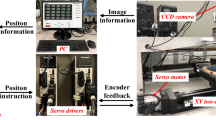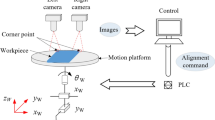Abstract
Positioning accuracy of chip directly impacts on the quality and efficiency of LED chip production. The purpose of this paper is to improve the chip positioning accuracy by improving the camera calibration algorithm of LED chip visual positioning system. Firstly, by making the error analysis for the visual positioning system, the systematic errors of each parts of the system are obtained, and the relationship between chip positioning error and chip position distribution in image is found. Then, according to the result of error analysis and the characteristics of the chip positioning process, an improved calibration algorithm is proposed to improve the chip positioning accuracy. This improved algorithm solves the calibration parameters in two steps, which highlights the main cause of errors in calibration process and meets the requirements of chip positioning. Finally, the experiment results show that the proposed algorithm can improve the chip positioning accuracy obviously, and has good stability and robustness.
Similar content being viewed by others
References
Wu T, Li B, Wang LW, Huang Y (2010) Automatic detect and match of LED dies basing on position relations between adjacent dies. Proceedings of the Ninth International Conference on Machine Learning and Cybernetics, Qingdao 3:1195–1200. doi:10.1109/ICMLC.2010.5580907
Zhong F, He S, Li B (2015) Blob analyzation-based template matching algorithm for LED chip localization. Int J Adv Manuf Technol. doi:10.1007/s00170-015-7638-5
Conte J, Majarena AC, Aguado S, Acero R, Santolaria J (2015) Calibration strategies of laser trackers based on network measurements. Int J Adv Manuf Technol 83(5):1161–1170. doi:10.1007/s00170-015-7661-6
Faig W (1975) Calibration of close-range photogrammetry systems: mathematical formulation. Photogramm Eng Remote Sens 41(12):1479–1486
Abdel-Aziz YI, Karara HM, Hauck M (2015) Direct linear transformation from comparator coordinates into object space coordinates in close-range photogrammetry. Photogramm Eng Remote Sens 81(2):103–107
Tsai RY (1986) An efficient and accurate camera calibration technique for 3D machine vision. Proceedings of IEEE Computer Vision and Pattern Recognition Conference 1986:364–374
Weng J, Cohen P, Herniou M (1990) Calibration of stereo cameras using a non-linear distortion model [CCD sensory]. International Conference on Pattern Recognition 1:246–253
Faugeras OD, Luong QT, Maybank SJ (1992) Camera self-calibration: theory and experiments. European Conference on Computer Vision 588(12):321–334
Hartley RI (1994) Projection reconstruction and invariants from multiple images. IEEE Trans Pattern Anal Mach Intell 16(10):1036–1041
Triggs B (1997) Autocalibration and the absolute quadric. Conference on Computer Vision and Pattern Recognition 22(8):609–614
Bajramovic F, Ckner M, Denzler J (2012) An efficient shortest triangle paths algorithm applied to multi-camera self-calibration. Journal of Mathematical Imaging and Vision 43(2):89–102
Pollefeys M, Gool LV, Oosterlinck A (1996) The modulus constraint: a new constraint self-calibration. International Conference on Pattern Recognition 1:349–353
Zhao L, Wu C, Liu S (2012) A self-calibration method based on two pairs of orthogonal parallel lines. International Conference on Intelligent Networking and Collaborative Systems 40(9):373–376
Galetto M, Mastrogiacomo L, Pralio B (2011) MScMS-II: an innovative IR-based indoor coordinate measuring system for large-scale metrology applications. Int J Adv Manuf Technol 52(1):291–302. doi:10.1007/s00170-010-2717-0
Li J, Yang Y, Fu G (2011) Camera self-calibration method based on GA-PSO algorithm. International Conference on Cloud Computing and Intelligence Systems 2011:149–152
Akkad NE, Saaidi A, Satori K (2012) Self-calibration based on a circle of the cameras having the varying intrinsic parameters. International Conference on Multimedia Computing and Systems 248(4):161–166
Merras M, Akkad NE, Saaidi A, Nazihl AG (2013) A new method of camera self-calibration with varying intrinsic parameters using an improved genetic algorithm. International Conference on Intelligent Systems: Theories and Applications 24(4):1–8. doi:10.1109/SITA.2013.6560799
Bellandi P, Docchio F, Sansoni G (2013) Roboscan: a combined 2D and 3D vision system for improved speed and flexibility in pick-and-place operation. Int J Adv Manuf Technol 69(5):1873–1886. doi:10.1007/s00170-013-5138-z
Muruganantham C, Jawahar N, Ramamoorthy B, Giridhar D (2008) Optimal settings for vision camera calibration. Int J Adv Manuf Technol 42(7):736–748. doi:10.1007/s00170-008-1634-y
Hartley RI (1997) Self-calibration of stationary cameras. Int J Comput Vis 22(1):5–23
Ma SD (1996) A self-calibration technique for active vision systems. IEEE Transactions on Robotics & Automation 12(1):114–120
Xiong JL, Zhang Q, Xia JY, Peng S (2009) A linear self-calibration method based on active vision system. International Congress on Image and Signal Processing 2009:1–4
Shih CL, Ruo CW (2005) Auto-calibration of an SMT machine by machine vision. Int J Adv Manuf Technol 26(3):243–250. doi:10.1007/s00170-003-1765-0
Zhan Q, Wang X (2012) Hand–eye calibration and positioning for a robot drilling system. Int J Adv Manuf Technol 61:691–701. doi:10.1007/s00170-011-3741-4
Author information
Authors and Affiliations
Corresponding author
Rights and permissions
About this article
Cite this article
Wang, Z., Gong, S., Li, D. et al. Error analysis and improved calibration algorithm for LED chip localization system based on visual feedback. Int J Adv Manuf Technol 92, 3197–3206 (2017). https://doi.org/10.1007/s00170-017-0390-2
Received:
Accepted:
Published:
Issue Date:
DOI: https://doi.org/10.1007/s00170-017-0390-2




